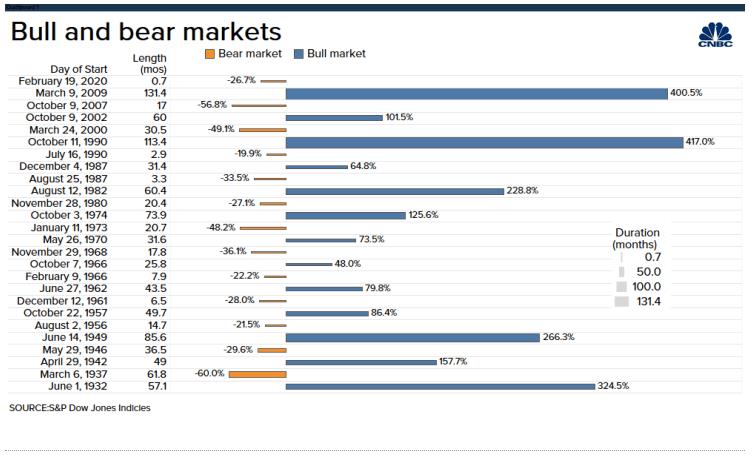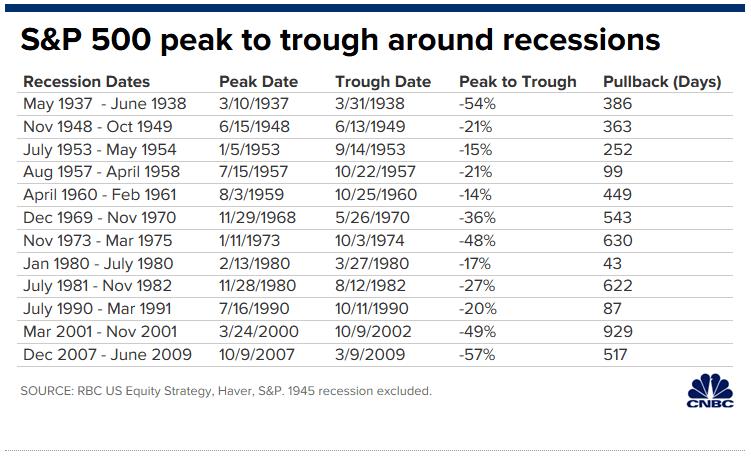And just like that, the S&P 500, Nasdaq, and Dow Jones hit their all-time highs, and the COVID-19 market sell-off had been erased. Just before the COVID-19 pandemic struck the markets, Ray Dalio was recklessly dismissive of cash positions, stating "cash is trash." Even Goldman Sachs proclaimed that the economy was recession-proof via "Great Moderation," characterized by low volatility, sustainable growth, and muted inflation. Not only were these assessments incorrect, but they were ill-advised in what was an already frothy market with stretched valuations prior to COVID-19. I'm sure Ray Dalio quickly realized that his "cash is trash" mentality, and public statements were imprudent. The COVID-19 pandemic has been a truly back swan event that no one saw coming. This health crisis has crushed stocks and decimated entire industries such as airlines, casinos, travel, leisure, and retail with others in the crosshairs.
The S&P 500, Nasdaq, and Dow Jones shed over a third of their market capitalization at the lows of March 2020. Some individual stocks lost over 70% of their market capitalization. Other stocks had been hit due to the market-wide meltdown, and many opportunities were presented as a result. Investors were presented with a unique opportunity to start buying stocks and take long positions in high-quality companies. Throughout this market sell-off, I started to take long positions in individual stocks, particularly in the technology sector and broad market ETFs that mirror the S&P 500, Nasdaq, and Dow Jones. It was important to put this black swan into perspective and see through this crisis on a long term basis while viewing COVID-19 as an opportunity that only comes along on the scale of decades.
Most Extreme and Rare Sell-Off Ever
The abrupt and drastic economic shutdown and velocity of the U.S. market's ~30% drop within a month bring parallels to the 1930s. This sell-off was extreme and rare in its breadth, nearly evaporating entire market capitalizations of specific companies. The pace at which stocks dropped from all-time highs was the fastest in history. The major averages posted their worst week since the financial crisis (Figures 1 and 2). The Dow had its worst month since 1931, and the S&P had its worst month since 1940.

Figure 1 – Dramatic market sell-offs, COVID-19 leading to the sharp market decline of over 30% in less than a month

Figure 2 – Major market sell-offs and their corresponding peak-to-trough declines
See Through This Black Swan Event
Investors had to heed this unique opportunity to invest in stocks and stay the course over the long term. Investment opportunities were provided over this rapid sell-off when broader indices were off 10%, 20%, 30%, and 30%-plus. Relative to historical sell-offs, anything greater than a 12% decline is a good starting opportunity to start taking long positions in the broader indices. Per Bank of America, looking at data going back to 1930, if an investor missed the S&P 500′s 10 best days in each decade, total returns would be just 91%, compared to the 14,962% return for investors who held steady throughout the ups and downs (Figure 3).

Figure 3 – Trying to time the market and potentially missing some of the best days can be detrimental to one's portfolio
The S&P 500 was down over 30% below its peak back on February 19. The index traded at ~14 times earnings for 2019. If next year recovers to the 2018-19 level again of $165 per share, the market is still at 14 times forward earnings, which is a discount to historic P/E multiples. The market traded at a P/E of 14.5 during the market meltdown in Q4 2018. Previous bottoms have seen lower P/Es in history with a P/E of 11 on March 9, 2009, the bottom during the financial crisis.
It's noteworthy to point out the Dow Jones' five worst single-day point drops, and the four best single-day point gains have all been in March. At a certain point, there would be an inflection point, and one of those big rallies will mark the turn in the market, which we have seen through the end of August 2020. Had you sold during the lows, you were left on the sidelines, hurting your long-term returns per the data.
|
This list ranks the top optionable stocks daily based on trend, volume, price and our proprietary algorithm. FREE Bonus: The Strategy Used To Make 5 Million In 2 Years! |
Per Bank of America, "the probability of losing money plummets to 0% over a 20-year time horizon." Time and again, bear markets have proven to be good buying opportunities; however, it can just take several years for the gains to be realized.
"Investors with longer-term investment horizons should remain invested in stocks," Goldman said, while Bank of America noted that "time is money for equities." The firm added that "for equity investors, the best recipe for loss avoidance is time: as time horizons lengthen, the probability of losing money in stocks has decreased."
Initiating Long and Speculative Positions
The S&P 500, Dow Jones, and Nasdaq were down over a third from their highs. Throughout this stretch of market weakness, I started to buy long positions in names that presented compelling value and growth beyond the COVID-19 health crisis. These names were well-positioned to explode higher when the market inevitably rebounded. Many of these positions were purchased well off their highs, and I've averaged down throughout the sell-off. Some positions were initiated too early in hindsight; however, I've scaled into these names over time with multiple purchases in small increments (Table 1).

Table 1 – Example of some long positions that were purchased in small increments throughout the market sell-off, locking in double-digit discounts from 52-week highs. Several positions are nearing 100% returns (i.e., Apple, Amazon, and Nasdaq ETF)
Conclusion
After the epic COVID-19 induced sell-off, stocks were too cheap to ignore, and starting to buy at those levels was prudent. There was a wide array of high-quality names selling at deep discounts with some off ~50% from their 52-week highs. When you sell during a panic, you may miss the market's best days as rapid sell-offs often lead to quick bounces. COVID-19 sent shock waves through the markets, causing double-digit declines across all major indices. Selling has proven to put investors at risk for missing out on some of the best days moving ahead for the market, as we've seen unfold through the end of August 2020. The COVID-19 induced sell-off presented a great opportunity to take long positions on high-quality names such as Apple (AAPL), Amazon (AMZN), Microsoft (MSFT), Google (GOOGL), Nasdaq (QQQ), Dow Jones (DIA), and S&P 500 (SPY) to name a few with the broader indices serving as a core foundation of any portfolio.
Noah Kiedrowski
INO.com Contributor
Disclosure: The author holds shares in AAL, AAPL, AMC, AMZN, AXP, DIA, GOOGL, JPM, KSS, MSFT, QQQ, SPY and USO. He may engage in options trading in any of the underlying securities. The author has no business relationship with any companies mentioned in this article. He is not a professional financial advisor or tax professional. This article reflects his own opinions. This article is not intended to be a recommendation to buy or sell any stock or ETF mentioned. Kiedrowski is an individual investor who analyzes investment strategies and disseminates analyses. Kiedrowski encourages all investors to conduct their own research and due diligence prior to investing. Please feel free to comment and provide feedback, the author values all responses. The author is the founder of www.stockoptionsdad.com where options are a bet on where stocks won’t go, not where they will. Where high probability options trading for consistent income and risk mitigation thrives in both bull and bear markets. For more engaging, short duration options based content, visit stockoptionsdad’s YouTube channel.

There are many "swamis" presenting their "views" of the future in their crystal balls, but, I have found INO.COM to be the most reliable in their suggestions. Keep up the good work.
TTHANK YOU, and stay safe.
Thank you for the kind words Kazu!
Best,
Jeremy